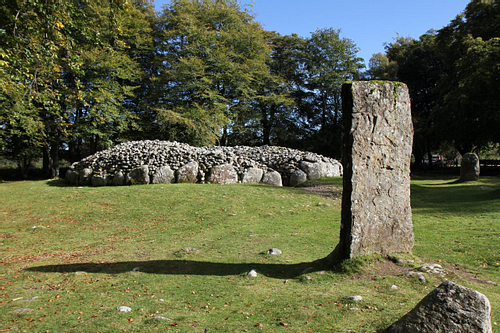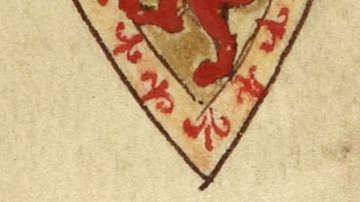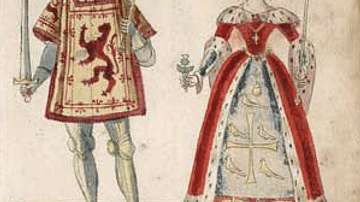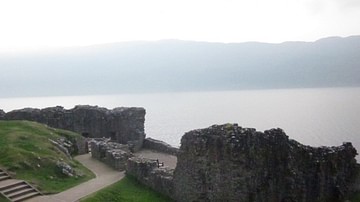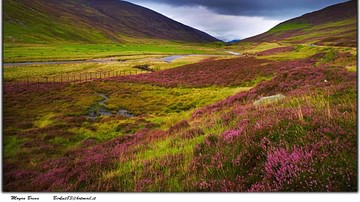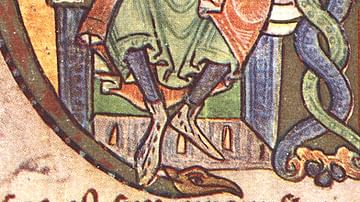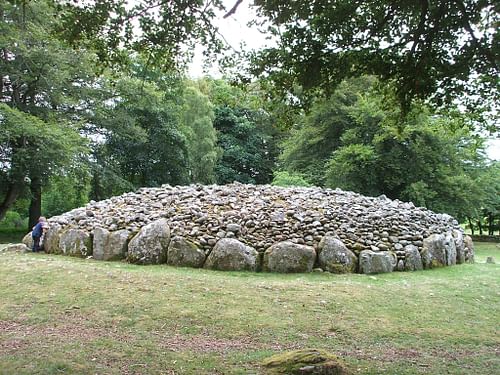
Clava Cairns is an early Bronze Age site in Scotland, located east of the city of Inverness, consisting of three well-preserved cairns (two of which are passage graves) and a number of free-standing stones strategically placed for astronomical purposes. The full name of the site is the Prehistoric Burial Cairns of the Balnuaran of Clava which is usually shortened to The Balnuaran of Clava and, informally, Clava Cairns. Although formerly classified as a Neolithic Period site, in 2000 CE Professor Richard Bradley conclusively proved it was constructed in the Bronze Age and, since the publication of his work, similarities between the monuments at Clava Cairns and other Bronze Age sites have been increasingly noted.
The cairns date from c. 2500 BCE, but the location is thought to have been in use much earlier, and later additions date to c. 2000 BCE. The site was in continual use for over 1000 years and evidence suggests reuse by communities, intermittently, until 770 CE as a burial ground and center for rituals. The cairns themselves have been identified as graves but were clearly constructed with astronomical alignments in mind. Scholars Alwyn and Brinley Rees define the meaning of a cairn:
A cairn is a mound of stones erected over a burial or at some other point with other-world associations, such as wherever a man has died out-of-doors or where a coffin has rested. (188)
Even so, a cairn may also represent wholeness and specifically the whole of a country, of a collective people, such as those in Ireland or Scotland, which both have a significant number of cairns throughout. The scholars Rees discuss the significance of the cairns of Ireland:
Every beehive tomb in Greece is a symbol of the omphalos ('navel' of the earth); every stupa (gravemound) in India is a miniature of Mount Meru in the middle of the world. In Yorubaland, [the ethnologist] Leo Frobenius found little clay cult objects which consisted of a central cone, representing the god of world order, with four smaller cones around it representing the gods of the cardinal points. Similarly, every cairn in Ireland represents the whole. (187-188)
In this same way, it is thought, Clava Cairns represented Scotland as a whole but, more importantly, Scotland's specific place in the universe. According to Andis Kaulins of Megaliths.net, 'Bal' meant 'Pole' and 'Nuaran' 'River of Light', thus linking the site to the Milky Way and designating Balnuaran as the center of the heavens from which the ancients could chart the stars. There are 45 other cairns in the Inverness-Nairn valley which form a definite pattern corresponding to the planets, but this particular site seems to have a special resonance with the people as evidenced by the construction of the cairns in their original state, which differs from other sites on a grander scale.
Scholarship on the site agrees that it was once not only an astronomical observatory but also a burial ground for the most prestigious members of the local community. It is evident that the cairns were constructed to honor the dead but, at the same time, to mark the passing of the seasons and provide people with a means of regulating a calendar. The passage graves are aligned to the winter solstice and the standing stones, likewise, serve astronomical purposes. At the same time, however, the monuments may have served a spiritual/religious purpose as physical evidence of their original lavish construction and ring-and-cup marks on the stones suggests.
The Cairns at Clava
Excavations at the site began in 1828 CE and continued, at intervals, through the 1990s CE. The most recent, and extensive, work has been done by Professor Richard Bradley whose work The Good Stones: A New Investigation of the Clava Cairns maintains that the location of the cairns was not only essential to astronomical observations but also to communication between different communities in different regions.
The site is located at the northeastern end of the Great Glen of the Highlands of Scotland which people used – and still do today – in traveling from the north of Scotland to the south and west. Clava Cairns, then, could have served as some central meeting place which clans far to the south could have easily located; all they would have to do would be to follow the Great Glen north.
The cairns at the site have been designated the North-East Cairn, Central Cairn, and South-West Cairn. It is thought that there were at least two other cairns at the site which are no longer extant. The North-East and South-West Cairns are both passage graves with entrances built leading to a circular center. The Central Cairn completely encloses the circular space inside, and it is thought that bodies may have been cremated here based on finds in the 1950s CE which uncovered cremated bone and evidence of recurring fires.
There is a fourth, poorly preserved, structure at the site known as the Kerb Cairn which, today, is only a circle of stones near to the Central Cairn. The 1950's CE excavations designated this stone ring a gravesite, though no human remains were uncovered, based on the similarity of construction to the nearby ancient cemetery of Milton of Clava. All three cairns are surrounded by upright, slender, standing stones of slightly different color.
While these upright stones bear no symbols, some of the stones which make up the cairns are inscribed with ring-and-cup marks. Examples of the mysterious circles carved in stones have been found all over the United Kingdom and beyond. No one knows what the circles symbolized to the ancient carvers, but it appears the petroglyphs were wrought using stone tools or deer antlers.
It is possible – even likely – that the ring-and-cup marks symbolize an unknown tripartite deity or the Triple-Goddess of the Maiden-Matron-Crone who appear in a number of locales throughout the Celtic world. The marks might also suggest the journey through life as symbolized by the spiral which would mirror the construction of the passage graves as a kind of labyrinth.
Bradley's Excavations
The North-East and South-West passage graves, excavated by Professor Bradley in the 1990s CE along with the rest of the site, exemplify these engravings, but whether these were carved into the stones before they were in place or after is unknown. Professor Bradley concluded that the entire site was originally constructed during a single phase, but this only means that the stones and the cairns were erected at once, and it sheds no light on whether the ring-and-cup marks were engraved before or after the stones were set in place.
Digs at the site have revealed bone fragments indicating that this site, like others, was most certainly a burial ground. Bradley reports:
A few flecks of cremated bone were found on the surface of the platform [of the north-east cairn and] over a hundred lithic artifacts were recovered during the excavation and samples were taken for study by soil micromorphology, pollen analysis and radiocarbon dating. (Bradley, 1, Historic Environment Record)
It appears, however, that it served as a final resting place for a very select few and was not a cemetery for the common people. No complete skeletal remains have been recovered from the site, and it is probable that only one person was buried in each of the cairns or, perhaps, only a single person at the entire site.
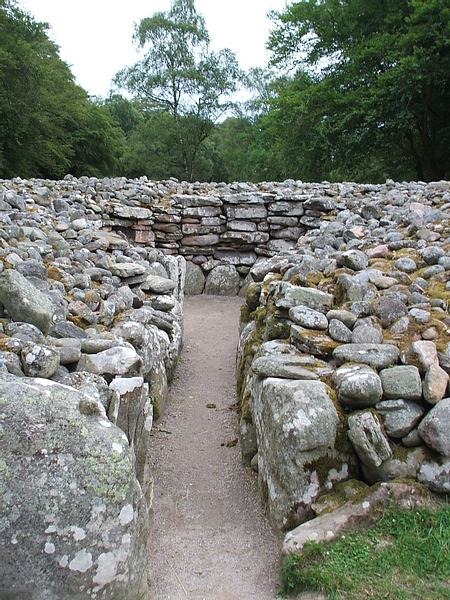
It has been speculated, based on the amount of quartz found in proximity to the cairns, that they were once adorned with the white stone which would have caused them to almost glow and this suggests the importance of the site to ancient people. Professor Bradley has shown that stone rubble was used to initially help hold the larger stones of the cairns in place and that this rubble then extended outwards toward the eleven monoliths which surround the site. These smaller rocks and gravel, after the stones of the cairns were fully situated, were then spread to form an even platform between the structures and the monoliths so that, taken together with the quartz-covered cairns, the site would have been most impressive.
Astronomical Significance
Professor Alexander Thom conclusively showed, in the 1940s CE, that the entranceways of the passage graves align directly and, in correspondence with the standing stones, point to the winter sun's setting position. The cairns are now all open to the sky and rise to a height of about five feet (1.5 m) but evidence suggests that they were once much higher than the ruins one sees today, probably at least ten feet (3 m) tall, and that the inner chamber of each cairn was enclosed by a roof.
On the winter solstice, sunlight beams directly into the chambers of the passage graves, illuminating the rooms which would have been in darkness the rest of the year. Regarding this, Historic Scotland observes:
The [North-East Cairn] is aligned on the midwinter solstice. In recent years this phenomenon has been observed by covering the chamber and passage with tarpaulin. This showed that on a clear day the rays of the setting sun travel down the passage and divide the chamber in half. A beam of intense light focuses on the back wall. The same effect would have been visible in the south-west cairn where the view is obstructed by a modern farmhouse. (Historic Scotland.gov.uk)
The midwinter solstice is recognized as a matter of considerable importance to the ancients as so many early structures are found aligned to it (such as the famous site of Maeshowe in Orkney, Scotland, and Newgrange in Ireland, to name only two). As with more famous locations, the cairns at Clava are situated so precisely that, when considered in a pattern with other sites nearby, an astronomical purpose is very clearly suggested. Scholars John and Julia Keay write:
It has been noted that a line through the passages of the two passage graves points exactly to a spot on the horizon corresponding to the midwinter sunset. This is unlikely to be fortuitous, although the significance and meaning of the alignment is a matter of controversy. It also appears that the cairns and their surrounding stone circles are laid out with complex geometrical accuracy, suggesting a knowledge of practical mathematics and astronomy. (165)
The “controversy” the Keays allude to is the interpretation of the site by visitors in the modern day who often conclude, skeptically, that the cairns are simply mounds of stones farmers cleared from their fields and piled in heaps. This interpretation is untenable when one considers the precision with which the cairns are constructed, their astronomical alignment, and the physical evidence of long use of the site as ritually significant. Further, as has been noted, the cairns at Clava form a discernible pattern with other monuments in the area but were constructed on a grander scale, which makes clear that this site was significantly more important than the others. The Keays note:
Other cairns of this type in the Inverness area suggest a regional Bronze Age culture which built its burial cairns to a slightly different pattern to other regions of Scotland. The Clava type is very distinctive, although it incorporates the same elements – burial chamber, passages, kerbs – found elsewhere. (165)
The distinctive nature of the cairns at Clava no doubt had a specific meaning but what the meaning might be is unknown. It is certain, however, that these cairns – as others throughout Scotland, Ireland, Britain, and elsewhere – were constructed as monuments intimately connected to memory.
Memory & the Cairns of Clava
From ancient times to the present day, people keep the past alive through remembrance. Ancient Mesopotamian tombs were inscribed with the name and deeds of the deceased just as they were in Egypt, China, Greece, Rome, and elsewhere. In ancient Greece, in fact, the remembrance of the dead ensured their survival in the afterlife, and in Egypt, tomb offerings were made daily for the sustenance of the departed. In China, tomb-sweeping day – in which one visits and tends to the graves of one's relatives – has been observed for centuries and continues to be in the present day.
It is probable, then, whatever other uses Clava Cairns served, it was a place of remembrance. The astronomical positioning of the graves and standing stones would not have taken away from the aspect of those structures as memorials either to an individual, a group, an event, or a reminder of the essential nature of life as change and one's eternal journey after death. Scholar Rodney Castleden writes:
Long memories are characteristic of Celtic communities. The Druids leaned totally on memory. They had to devote themselves to great efforts of learning. Julius Caesar noted that the Druids “are said to learn by heart a great number of verses.” They went so far as to spurn writing in order to intensify their dependence on memory. In Druidry there is a deep and abiding connection between memory and nature. The earth itself is regarded as remembering everything; it is a witness to history in a way that we cannot fully appreciate. (447)
Anyone who has spent any time in Ireland or Scotland is aware of the power and strength of the Celtic memory. Along these lines, the cairns would have served as memorials; although what exactly they were memorializing remains uncertain. The ring-and-cup marks at the site continue to defy efforts at interpretation – as they do elsewhere – but could signify the mystical concept of the Rule of Three in which “multiplying an image was a simple way of emphasizing it” and “the most common way of doing this was to multiply an image by three” (Castleden, 459). Deities are frequently represented in Celtic iconography in three's – as they are elsewhere – but the ring-and-cup marks might also represent individuals or, placed as they are at Clava Cairns, the spiral concept of the labyrinth.
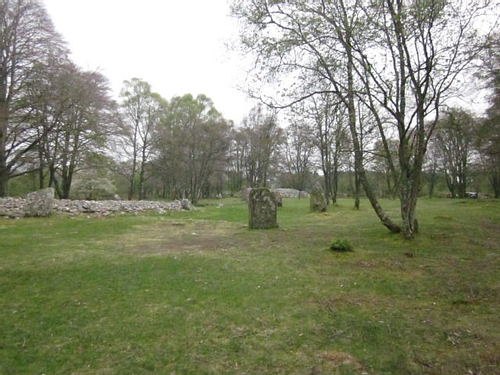
Labyrinths, whether in ancient Egypt or Greece, were associated with the dead and one's journey through the afterlife but are also associated with one's life prior to death and one's journey to wholeness. The choices one makes inside a labyrinth either confuse and lead to frustration and loss or strengthen and lead to completion and fulfillment. Castleden observes that “the spiral is the simplest form of labyrinth, one in which no choices are presented beyond the choice to travel. It is a single path, a path to the center and back” (467). The passage graves at Clava Cairns certainly present one with only this one choice and the ring-and-cup marks could have been carved to emphasize the cyclical nature of life so inherent in Celtic mythology and lore.
In this view, nothing and no one ever dies; all things merely change and become something else. The seemingly linear path one travels between birth and death does not actually begin at birth or end with death; everything that dies comes back in some renewed form or continues on eternally. The cairns at Clava could have been raised to emphasize this understanding as well as commemorate those who had passed on to the next phase of existence on their eternal journey.
